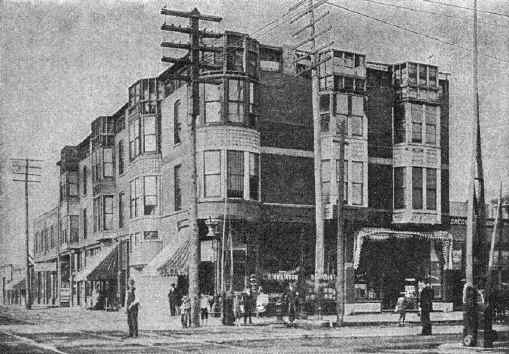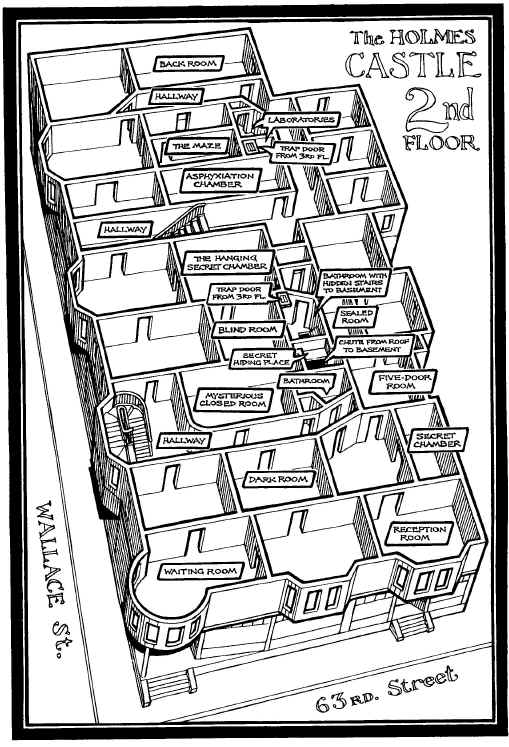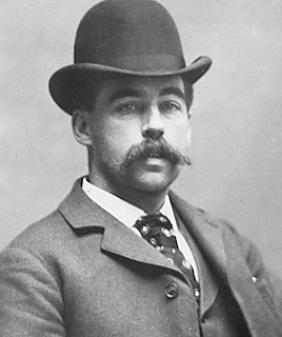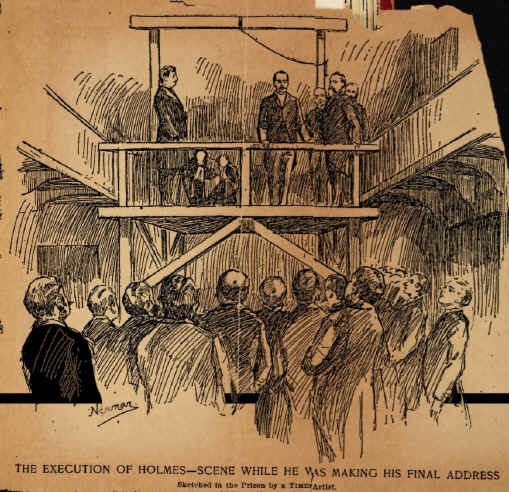|
The Murder Hotel at the Columbian Exposition
Herman Webster Mudgett, better known as Dr. Henry Howard Holmes or more
commonly known as H. H. Holmes, was an American serial killer of the
19th century. He was born in Gilmanton, New Hampshire on May 16, 1861.
 Sometimes
referred as the Beast of Chicago, Holmes killed his victims in his
specially constructed home, referred to as the World's Fair Hotel, and
later nicknamed the The Murder Hotel. The home was located 3 miles west
of the 1893 World's Fair: the Columbian Exposition. Evidence suggests
that the hotel portion was never officially open for business. Sometimes
referred as the Beast of Chicago, Holmes killed his victims in his
specially constructed home, referred to as the World's Fair Hotel, and
later nicknamed the The Murder Hotel. The home was located 3 miles west
of the 1893 World's Fair: the Columbian Exposition. Evidence suggests
that the hotel portion was never officially open for business.
Born to an affluent family, Holmes had a privileged
childhood. It has been said that he appeared to be unusually intelligent
at an early age. There were haunting signs of what was to come. He
expressed an interest in medicine, which reportedly led him to practice
surgery on animals. Some accounts indicate he may even have been
responsible for the death of a young childhood friend.
At the age of 16, Holmes graduated from high school
and took teaching jobs in Gilmanton and later in nearby Alton. On July
4, 1878, he married Clara Lovering in Alton. Their son, Robert Lovering
Mudgett, was born on February 3, 1880, in Loudon, New Hampshire.
Holmes enrolled in the University of Vermont in
Burlington at age 18, but was dissatisfied with the school and left
after only one year. In 1882, he entered the University of Michigan's
Department of Medicine and Surgery and graduated in June 1884. While
enrolled, he worked in the anatomy lab. Holmes had previously
apprenticed in New Hampshire under Dr. Nahum Wight, a noted advocate of
human dissection.
 When
in medical school at the University of Michigan, he stole several
corpses from the lab, disfigured them, and tried to collect insurance by
saying they died in an accident. Over the years, he perfected these
scams, and supposedly became the beneficiary on the policies of several
women who worked for him, many of whom mysteriously disappeared. When
in medical school at the University of Michigan, he stole several
corpses from the lab, disfigured them, and tried to collect insurance by
saying they died in an accident. Over the years, he perfected these
scams, and supposedly became the beneficiary on the policies of several
women who worked for him, many of whom mysteriously disappeared.
Housemates described Holmes as treating Clara
violently, and in 1884, before his graduation, she moved back to New
Hampshire and later wrote that she knew little of him afterwards. After
he moved to Mooers Forks, New York, a rumor spread that Holmes had been
seen with a little boy who later disappeared. Holmes claimed the boy
went back to his home in Massachusetts. No investigation took place and
Holmes quickly left town. He later traveled to Philadelphia and
eventually got a job as a housekeeper at Norristown State Hospital, but
quit after a few days. He then took a position at a drugstore in
Philadelphia, but while he was working there, a boy died after taking
medicine that was purchased at the store. Holmes denied any involvement
in the child's death and immediately left the city. Right before moving
to Chicago, he changed his name to Henry Howard Holmes to avoid the
possibility of being exposed by victims of his previous scams.
In late 1886, while still married to Clara, Holmes
married Myrta Belknap in Minneapolis, Minnesota. He filed for divorce
from Clara a few weeks after marrying Myrta, alleging infidelity on her
part, but the claims could not be proven and the suit went nowhere.
Surviving paperwork indicated that she probably was never even informed
of the suit. In any event the divorce was never finalized. It was
dismissed June 4, 1891, on the grounds of "want of
prosecution". Holmes had a daughter with Myrta, Lucy Theodate
Holmes, who was born on July 4, 1889, in Englewood, Chicago. Holmes
lived with Myrta and Lucy in Wilmette, Illinois, and spent most of his
time in Chicago tending to business. Holmes married Georgiana Yoke on
January 17, 1894, in Denver, Colorado, while still married to both Clara
and Myrta.
Soon after his arrival in the Chicago area, Holmes
took up work at a pharmacy located near Jackson Park. Eight years later,
Jackson Park would become the site of the 1893 Chicago World’s Fair.
Historians believe Holmes, a masterful and charismatic con artist, had
swindled money from his drugstore employers. He purchased an empty lot
in the Englewood neighborhood of Chicago, and built a labyrinthine
structure with shops on the first floor and small apartments above.
 This
building became Holmes’ booby-trapped castle of horrors. The space
featured soundproof rooms, secret passages and a disorienting maze of
hallways and staircases. Most of the rooms had gas vents, which were
controlled from the killer's bedroom. Many of the rooms were soundproof
and could only be locked from the outside. One chilling room featured a
dissecting table, stretching rack and industrial oven. Holmes would
often dissect his victims and strip them of their flesh. He would then
cash in and sell their bones to medical schools as human skeleton
models. This
building became Holmes’ booby-trapped castle of horrors. The space
featured soundproof rooms, secret passages and a disorienting maze of
hallways and staircases. Most of the rooms had gas vents, which were
controlled from the killer's bedroom. Many of the rooms were soundproof
and could only be locked from the outside. One chilling room featured a
dissecting table, stretching rack and industrial oven. Holmes would
often dissect his victims and strip them of their flesh. He would then
cash in and sell their bones to medical schools as human skeleton
models.
The rooms were also outfitted with trapdoors over
chutes that dropped Holmes’ unsuspecting victims to the building’s
basement. In the basement were acid vats, pits of quicklime and a
crematorium, which Holmes used to finish off his victims.
Holmes lured many visitors to the Columbian
Exposition to his sinister lair, with the promise of cheap lodgings. The
exact number of his victims is still debated by historians.
The Columbian Exposition, attracted more than 27
million visitors to Chicago, an incredible number considering the
limited transportation options of the time. Holmes took advantage of
some of the many visitors to the city, including young women who came to
Chicago for jobs at the fairgrounds. Unfortunately, some of his guests
did not survive his hospitality.
One of Holmes' early murder victims was his mistress,
Julia Smythe. She was the wife of Ned Icilius Conner, who had moved into
Holmes' building and began working at his pharmacy's jewelry counter.
After Conner found out about Smythe's affair with Holmes, he quit his
job and moved away, leaving Smythe and her daughter Pearl behind. Smythe
and Pearl remained at the hotel and she continued her relationship with
Holmes. Julia and Pearl disappeared on Christmas Eve of 1891, and Holmes
later claimed that she had died during an abortion, though what truly
happened to the two was never confirmed. Another likely Holmes mistress,
Emeline Cigrande, began working in the building in May 1892, and
disappeared that December. Another woman who vanished, Edna Van Tassel,
is also believed to have been one of Holmes' victims.
In early 1893, a one-time actress named Minnie
Williams moved to Chicago. Holmes claimed to have met her in an
employment office, though there were rumors that he had met her in
Boston years earlier. He offered her a job at the hotel as his personal
stenographer, and she accepted. Holmes was able to persuade Williams to
transfer the deed to her property in Fort Worth, Texas, to a man named
Alexander Bond, an alias of Holmes. In April 1893, Williams transferred
the deed, with Holmes serving as the notary. The next month, Holmes and
Williams, presenting themselves as man and wife, rented an apartment in
Chicago's Lincoln Park. Minnie's sister, Nannie, came to visit, and in
July, she wrote to her aunt that she planned to accompany "Brother
Harry" to Europe. Neither Minnie nor Nannie was seen alive after
July 5, 1893.
Holmes left Chicago after the World’s Fair. He left
caretakers in charge of the hotel with strict orders not to go to the
upper floors where the torture rooms were. He moved to Texas for a time,
intending to create another murder hotel, on the property he inherited
from the Williams sisters, but he eventually decided he didn’t like it
in Texas. He ended up in St. Louis where he was arrested for a horse
swindle, during which time he got the idea to make money by faking his
own death.
 He
eventually convinced a long time friend, Benjamin Pitezel, to help with
the scheme. Holmes used Pitezel as his right-hand man for several
criminal schemes. Pitezel would pretend to be an inventor injured in a
lab accident, and then they would fake his suicide for the insurance
money. The only problem for Pitezel was that Holmes didn’t fake the
death, he killed him. He
eventually convinced a long time friend, Benjamin Pitezel, to help with
the scheme. Holmes used Pitezel as his right-hand man for several
criminal schemes. Pitezel would pretend to be an inventor injured in a
lab accident, and then they would fake his suicide for the insurance
money. The only problem for Pitezel was that Holmes didn’t fake the
death, he killed him.
Holmes proceeded to collect the insurance payout on
the basis of the genuine Pitezel corpse. Holmes then went on to
manipulate Pitezel's unsuspecting wife into allowing three of her five
children, Alice, Nellie and Howard, to be in his custody. The eldest
daughter and the baby remained with Mrs. Pitezel. Holmes and the three
Pitezel children traveled throughout the northern United States and into
Canada. Simultaneously, he escorted Mrs. Pitezel along a parallel route,
all the while using various aliases and lying to Mrs. Pitezel concerning
her husband's death, claiming that Pitezel was hiding in London, as well
as lying to her about the true whereabouts of her three missing
children. Holmes was staying at another location with his wife, who was
unaware of the whole affair. Holmes would later confess to murdering
Alice and Nellie by forcing them into a large trunk and locking them
inside. He drilled a hole in the lid of the trunk and put one end of a
hose through the hole, attaching the other end to a gas line to
asphyxiate the girls. Holmes buried their nude bodies in the cellar of
his rental house at 16 St. Vincent Street in Toronto.
Holmes' murder spree finally ended when he was
arrested in Boston on November 17, 1894, after being tracked there from
Philadelphia by the Pinkerton National Detective Agency. He was held on
an outstanding warrant for horse theft in Texas, as the authorities had
become more suspicious at this point and Holmes appeared poised to flee
the country in the company of his unsuspecting third wife.
Frank Geyer, a Philadelphia police detective assigned
to investigate Holmes and find the three missing children, located the
decomposed bodies of the two Pitezel girls in the cellar of the Toronto
home. Detective Geyer wrote, "The deeper we dug, the more horrible
the odor became, and when we reached the depth of three feet, we
discovered what appeared to be the bone of the forearm of a human
being." Geyer then went to Indianapolis, where Holmes had rented a
cottage. Holmes was reported to have visited a local pharmacy to
purchase the drugs which he used to kill Howard Pitezel, and a repair
shop to sharpen the knives he used to chop up the body before he burned
it. The boy's teeth and bits of bone were discovered in the home's
chimney.
As police dug into Holmes’s background, they
learned from the custodians of the Chicago hotel that they were never
allowed to clean the top floor. The police investigated and found the
grisly remains of Holmes’s victims. While Holmes only confessed to
killing 27, police, at the time, estimated that the real number might be
closer to 100-200 victims, due to all the missing persons reports from
that area in the years Holmes was operating "The Murder
Hotel". Most believe the 100 figure is most accurate.
In October 1895, Holmes was put on trial for the
murder of Benjamin Pitezel, and was found guilty and sentenced to death.
By then, it was evident that Holmes had also murdered the Pitezel
children.
While in captivity, awaiting his trial and
sentencing, Holmes authored an autobiography, Holmes’ Own Story, in
which he wrote, "I could not help the fact that I was a murderer,
no more than the poet can help the inspiration to sing."
On May 7, 1896, Holmes was hanged at Moyamensing
Prison, also known as the Philadelphia County Prison, for the murder of
Pitezel. Holmes' neck did not snap; he instead was strangled to death
slowly, twitching for over 15 minutes before being pronounced dead 20
minutes after the trap had been sprung. Until the moment of his death,
Holmes remained calm and amiable, showing very few signs of fear,
anxiety or depression. Despite this, he asked for his coffin to be
contained in cement and buried 10 feet deep, because he was concerned
grave robbers would steal his body and use it for dissection.
Despite Holmes’ arrest and execution, rumors have
persisted for more than a century that the serial killer bribed
authorities to avoid punishment. The theories suggest that Holmes was
allowed to escape and that officials hanged another man.
In response to these rumors, in March 2017, Holmes’
descendants, who live in Delaware, petitioned to have his remains
exhumed so that they can undergo DNA testing.
University of Pennsylvania anthropologist Samantha
Cox, who did the forensic science on the exhumed remains, stated that
because of his unique burial requests, Holmes' body had not properly
decomposed. She said his clothes were almost perfectly preserved and his
mustache was intact on his skull. The corpse had decayed and because of
the condition of the body she couldn't get any DNA out of it. Instead
Holmes' teeth were used to identify him.
The fate of the site of the killer’s exploits is
also shrouded in intrigue. With Holmes, allegedly, in prison, in 1895,
the upper floor of the Murder Castle was gutted by fire, after witnesses
reportedly saw two men entering the building late one night.
The rest of the building remained standing until
1938, when it was torn down. The site is now occupied by the Englewood
branch of the U.S. Post Office.
|